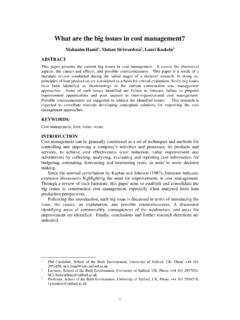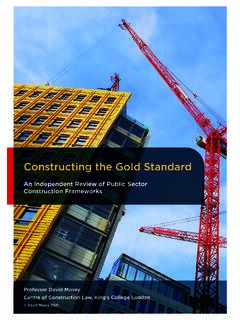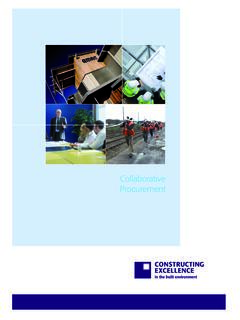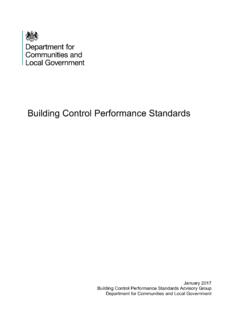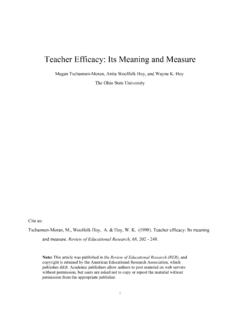Transcription of CUSTOMER SATISFACTION IN CONSTRUCTION
1 CUSTOMER SATISFACTION IN CONSTRUCTION . Sami Karna\ Juha-Matti Junnonen2 , and Jouko Kankainen3. ABSTRACT. CUSTOMER SATISFACTION can be seen either as a goal or as a measurement tool in the development of CONSTRUCTION quality. This paper examines empirically performance of Finnish CONSTRUCTION companies measured according to the degree of CUSTOMER SATISFACTION as perceived by customers themselves. The purpose of the study is to explore empirically the clients' main SATISFACTION /dissatisfaction factors. Empirical data is gathered from nearly 400. CONSTRUCTION projects in Finland. The views of CUSTOMER with respect to the performance of contractors are measured using five factors; quality assurance and handover, environment and safety at work, co-operation, personnel, site supervision and subcontracting.
2 Several implications regarding CUSTOMER SATISFACTION were drawn from the findings of the research. Customers were typically satisfied with the contractor's abilities to co-operate and the skills of contractor's workers and supervisors. In contrast, low SATISFACTION could be found for the items related to quality assurance and handover procedures and material. The common feature for the areas of low SATISFACTION items is that they come out in later phases of the CONSTRUCTION project . In generally, the quality of contracted work and of overall service level have an effect on general SATISFACTION . KEYWORDS. Performance measurement , CUSTOMER SATISFACTION , quality, CONSTRUCTION . Researcher, CONSTRUCTION Economics and Management, Helsinki University ofTechnology, Box 2100, Finland, Phone +358 9 451 5034, 2 Research Manager, CONSTRUCTION Economics and Management, Helsinki University of Technology, Box 2100, Finland, Phone +358 9 451 3 Professor, CONSTRUCTION Economics and Management, Helsinki University of Technology, Box 2100, Finland, Phone +358 9 451 1.
3 INTRODUCTION. CUSTOMER SATISFACTION is an important factor in the development of the CONSTRUCTION process and CUSTOMER relationship. As CONSTRUCTION companies face-increasing competition, greater attention continues to be placed on CUSTOMER relationships and satisfied customers. CUSTOMER SATISFACTION enables CONSTRUCTION companies to differentiate themselves from their competitors and create sustainable advantage. Many authors propose the importance of CUSTOMER SATISFACTION and its use for evaluating quality from the customers' perspective (Barret, 2000; Torbica and Stroh, 2001; Maloney, 2002; Yasamis et al, 2002). In order to measure CUSTOMER SATISFACTION in CONSTRUCTION , the main subjects must be identified. A CUSTOMER may be defined as the owner of the project and the one that needs the constructed facility.
4 In simple terms, the CUSTOMER is the buyer of the product or service. Kamara (2000) describes the ' CUSTOMER ' as a body that incorporates the interests of the buyer of CONSTRUCTION services, prospective users and other interest groups. In this paper, CUSTOMER is considered as a project owner or a general contractor in case of subcontracts in contrast of wider perspective, whereby CUSTOMER includes: the co-contractors and partners, project director, project team members, contractors and subcontractors, vendors and suppliers, users of the product and services and society. The objective of this research is to examine and deepen the understanding of CUSTOMER SATISFACTION in CONSTRUCTION . The following sections discuss these efforts with a literature review. Subsequently, the results of an empirical study are presented.
5 Finally a discussion and implications of the findings are presented. LITERATURE REVIEW. CUSTOMER SATISFACTION is typically viewed as a predictor for such behavioural variables as loyalty and purchase intentions (Jones and Sasser, 1995; Anderson and Sullivan, 1993). According to Jones and Sasser (1995), complete CUSTOMER SATISFACTION is the key to securing CUSTOMER loyalty and generating superior long-term financial performance. CUSTOMER SATISFACTION also appears to have a stronger and more consistent effect on purchase intentions than does service quality (Cronin and Taylor, 1992). It is also widely noticed that high CUSTOMER SATISFACTION leads to relationship strength and a deep state of collaboration has been found profitable ( Storbacka et al, 1994). Anderson et al.
6 (1994) examine briefly the links between CUSTOMER -based measures ( CUSTOMER SATISFACTION ) of firm performance and traditional accounting measures of economic returns. Their findings emphasise that firms, which achieve high CUSTOMER SATISFACTION also enjoy superior economic returns. Companies use various forms of CUSTOMER SATISFACTION approaches in developing and monitoring product/service offerings in order to manage and improve CUSTOMER relationships. In addition, measuring CUSTOMER SATISFACTION has several benefits for organisations: Improvement in communication between parties and enable mutual agreement a recognition ofthe demand of improvement in the process better understanding of the problems evaluation of progress towards the goal 2. monitoring and reporting accomplished results and changes To our knowledge, there are no common methods of measuring CUSTOMER SATISFACTION in the CONSTRUCTION industry.
7 Torbica & Stroh (2001) emphasize that the use of "soft" performance criteria, such as CUSTOMER SATISFACTION , in CONSTRUCTION is at an early evolutionary stage. The research literature has focused on SATISFACTION with consumer goods and services but a widely used measure of industrial customers SATISFACTION does not exist (Torbica and Stroh, 2001;. Homburg and Rudolph 2001). In addition, it is important to take into account that business- to-business marketing is more complex than consumer marketing. It is a more rationalized buying process; many more people and procedures are generally involved in the process, and products/services are more complex ( Cooper and Jackson, 1988). Tikkanen and Alajoutsijarvi (2002) also argue that measurement models in industrial markets are too simplistic and mechanistic to take into account the complexity of real-life.
8 Thus, the creation of a common SATISFACTION : measurement and procedure is important in CONSTRUCTION , where projects organizations and collaborative relationships often are of a 'one-off' nature. In CONSTRUCTION , the relationship between client and contractor constitutes a multilevel complex in which parties operate simultaneously and collaborate with in-groups of networks. Therefore, CUSTOMER SATISFACTION in CONSTRUCTION should be understood as a relationship- specific rather than a transaction specific construct (see Homburgh and Rudolph, 2001). In contrast to other areas of production, where the relationship between client and supplier is frequently long term, the relationship in CONSTRUCTION is periodic and dependent on the duration of the project . Generally, CONSTRUCTION does not share the benefits of regular-line activities.
9 As a result, traditional CUSTOMER relationship management models that have been used in product manufacturing will not produce the best result in CONSTRUCTION . In addition, the mutual co-operation between CUSTOMER and contractor is strongly emphasised and the CUSTOMER 's performance has considerable implications for the outcome of the CONSTRUCTION project . The complex nature of the CONSTRUCTION process, changes in project organisation, and the uniqueness of each project make it difficult to exploit past experiences and CUSTOMER feedback in the future. Soetanto et al. (200 1) additionally recognise the satisfactory performance of participants as a prerequisite to maintaining harmonious working relationships. They argue that SATISFACTION surveys provide information to project participants that can be used to help improve their performance.
10 Results of their importance-performance analysis suggest that contractors need to improve their performance in most aspects of performance. In terms of criteria in need for improvement, both clients and architects considered completion of defects the priority. Barrett (2000) similarly see that client SATISFACTION is the ultimate measure of CONSTRUCTION quality and will only be achieved if CONSTRUCTION companies adopt a strong external orientation in order to address the full range of quality dimensions that impact on the client. CUSTOMER SATISFACTION can be used for evaluation of quality and ultimately for assessment of the success of a company's quality improvement programme. According to Torbica and Stroh (2001), a quality improvement effort will lead to a higher product and service quality, which will lead to improved CUSTOMER SATISFACTION .




